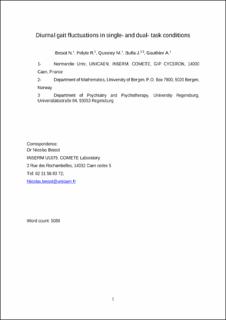| dc.contributor.author | Bessot, Nicolas | |
| dc.contributor.author | Polyte, Raphaël | |
| dc.contributor.author | Quesney, Marius | |
| dc.contributor.author | Bulla, Jan | |
| dc.contributor.author | Gauthier, Antoine | |
| dc.date.accessioned | 2021-05-10T09:33:04Z | |
| dc.date.available | 2021-05-10T09:33:04Z | |
| dc.date.created | 2020-08-23T14:36:43Z | |
| dc.date.issued | 2020 | |
| dc.identifier.issn | 0742-0528 | |
| dc.identifier.uri | https://hdl.handle.net/11250/2754578 | |
| dc.description.abstract | Gait is one of the most basic movements, and walking activity accomplished in dual task conditions realistically represents daily life mobility. Much is known about diurnal variations of gait components such as muscle power, postural control, and attention. However, paradoxically only little is known about gait itself. The aim of this study was to analyze whether gait parameters show time-of-day fluctuation in simple and dual task conditions. Sixteen young subjects performed sessions at five specific hours (06:00, 10:00, 14:00, 18:00 and 22:00 h), performing a single (walking or counting) and a dual (walking and counting) task. When performing gait in dual task conditions, an additional cognitive task had to be carried out. More precisely, the participants had to count backwards from a two-digit random number by increments of three while walking. Spatio-temporal gait parameters and counting performance data were recorded for analysis. Walking speed significantly decreased, while stride length variability increased when the task condition switched from single to dual. In the single-task condition, diurnal variations were observed in both walking speed and counting speed. Walking speed was higher in the afternoon and in the evening (14:00 and 22:00 h) and lower in the morning (10:00 h). Counting speed was maximum at 10:00 and 14:00 h and minimum at 18:00 h. Nevertheless, no significant diurnal fluctuation was substanytiated in the dual task condition. These results confirm the existing literature about changes in gait between single and dual task conditions. A diurnal pattern of single-task gait could also be highlighted. Moreover, this study suggests that diurnal variations faded in complex dual task gait, when the cognitive load nearly reached its maximum. These findings might be used to reduce the risk for falls, especially of the elderly. | en_US |
| dc.language.iso | eng | en_US |
| dc.publisher | Taylor & Francis | en_US |
| dc.rights | Attribution-NonCommercial-NoDerivatives 4.0 Internasjonal | * |
| dc.rights.uri | http://creativecommons.org/licenses/by-nc-nd/4.0/deed.no | * |
| dc.title | Diurnal gait fluctuations in single- and dual- task conditions | en_US |
| dc.type | Journal article | en_US |
| dc.type | Peer reviewed | en_US |
| dc.description.version | acceptedVersion | en_US |
| dc.rights.holder | Copyright 2020 Taylor & Francis Group, LLC | en_US |
| cristin.ispublished | true | |
| cristin.fulltext | postprint | |
| cristin.qualitycode | 1 | |
| dc.identifier.doi | 10.1080/07420528.2020.1773493 | |
| dc.identifier.cristin | 1824661 | |
| dc.source.journal | Chronobiology International | en_US |
| dc.source.pagenumber | 836-844 | en_US |
| dc.identifier.citation | Chronobiology International. 2020, 37(6), 836-844 | en_US |
| dc.source.volume | 37 | en_US |
| dc.source.issue | 6 | en_US |

